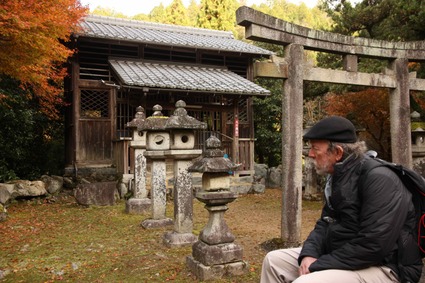 Those familiar with the Japanese mindset where sites of national significance and coloured leaves are concerned know it's a good idea to get in before the crowds start to arrive, and since the sites Madam had pencilled in for our only full day in Kyoto lay nine and a half kilometres from the CBD we were queuing for the Number 8 bus outside Karasuma Station well before the scheduled 7:22 departure.
Those familiar with the Japanese mindset where sites of national significance and coloured leaves are concerned know it's a good idea to get in before the crowds start to arrive, and since the sites Madam had pencilled in for our only full day in Kyoto lay nine and a half kilometres from the CBD we were queuing for the Number 8 bus outside Karasuma Station well before the scheduled 7:22 departure.
The journey out through the regulation urban landscape was mostly uneventful and we alighted around 8:15, turning our thoughts towards the morning's route march to Jingo-ji, which would involve an unspecified degree of climbing, while Kozan-ji would mean a bit of a walk.
As we set out along a relatively deserted back road that showed signs of imminent crowds, it was a pleasant and surprisingly tranquil stroll through autumn tones across a river valley and up and down the slopes on either side of the stream. As I walked, in between stopping to enjoy the views while someone lagged along behind capturing the interplay between light and leaves, I meditated on Zen and the art of walking with sore feet.
The walk up to the Kozan-ji took me right into Zen monks in the forest ambience, hardly surprising since the mountains around Togano, justly famous for their autumn foliage, have a long tradition of mountain asceticism. Heading back down the hill I wasn't exactly looking forward to our other temple visit since the morning was getting on and there were obvious expectations of substantial crowds among the roadside merchandisers. Fortunately, the monks who set about establishing these temples were careful to locate them where visitors would need to make a bit of effort and the founder of Jingo-ji must have liked his peace and quiet because he positioned the place at the top of several long flights of stairs. Jingo-ji, incidentally, dates back to 824.